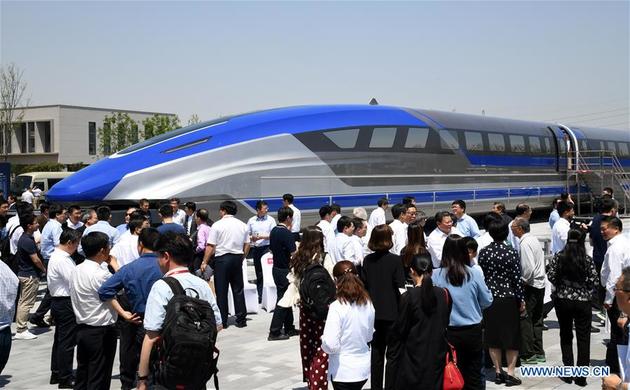
Photo/Xinhua
May 27 (NBD) -- A prototype magnetic-levitation train with a designed top speed of 600km per hour has rolled off the production line in China's eastern city Qingdao.
National Business Daily noticed that developed by China Railway Rolling Stock Corporation (CRRC) - one of the world's largest rail transit equipment suppliers, the engineering prototype is scheduled to go through comprehensive tests to finish integrated verification in 2021.
An emerging means of transportation, the magnetic-levitation train is characterized by high speed, low noise, vast passenger capacity and small vibration.
The maglev trains is able to fill the void between high-speed rail with a maximum operating speed of 350 km/h and the aircraft with a cruising speed of 800-900 km/h, news outlet Yicai reported citing Sun Zhang, a railway expert and professor at Tongji University in Shanghai.
"Take Beijing to Shanghai as an example -- counting preparation time for the journey, it takes about 4.5 hours by plane, about 5.5 hours by high-speed rail, and about 3.5 hours with the high-speed maglev," said CRRC Qingdao Sifang deputy chief engineer Ding Sansan, head of the train's research and development team in an interview with media.
Apart from filling the gap between high-speed rail and air transportation, the maglev technology constitutes a high ground of the international arena in the rail transit sector, Sun Zhang noted.
Countries such as Japan and Germany are working on their own maglev trains.
Japan started its experiments in 1972 and now has an experimental maglev track of 42.8 km in Yamanashi. In 2015, a maglev train achieved a top speed of 603 km/h on the Yamanashi line, setting a world record.
Japan is now developing a new Chuo Shinkansen maglev line, with trains set to hit top speeds of about 500 km/h. The first phase of the project, connecting Tokyo and Nagoya, is scheduled to be completed in 2027 and is expected to cut traveling time between those cities by half.
However, experts pointed out there is still a long way to go before the maglev train becomes a means of public transportation, taking into consideration composite costs, the market, economic significance, etc.
Taking costs for example, a total investment of 8.9 billion yuan (1.3 billion U.S. dollars) was put into a 30-kilometer stretch between Shanghai Putong Airport and the city center, the world's first commercial maglev system.
Zhao Jian, professor at Beijing Jiaotong University, told Yicai that there hasn't been corresponding maglev tracks except a prototype rolling off the assembly line, adding that it will take more than a decade or longer for an average citizen to take a maglev train, as a combination of questions pertaining to the market size, the traffic volume and the costs remain to be answered.
Email: gaohan@nbd.com.cn


 川公网安备 51019002001991号
川公网安备 51019002001991号





